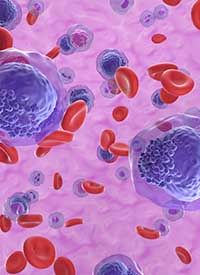News
Article
JAK Inhibitors Continue to Shape the Treatment Landscape of Myelofibrosis
Author(s):
Following the FDA approvals of the JAK inhibitors ruxolitinib, fedratinib, and pacritinib, the treatment landscape of myelofibrosis continues to grow with the use of these agents with an additional FDA review planned for momelotinib in September 2023.
Blood Cancer © stock.adobe.com

Following the FDA approvals of the JAK inhibitors (JAKi) ruxolitinib (Jakafi), fedratinib (Inrebic), and pacritinib (Vonjo), the treatment landscape of myelofibrosis (MF) continues to grow with the use of these agents with an additional FDA review planned for momelotinib in September 2023.
With multiple JAKi now options in this treatment space , patient- and disease-specific factors are vital when determining the most appropriate therapy plans. Symptom and spleen assessments, the presence of cytopenias, and risk stratification are key factors to consider prior to treatment with a JAKi. Moreover, hematopoietic stem cell transplant candidacy should be considered at diagnosis, as this remains the only potentially curative therapy for patients with MF. Patients with significant symptomatology, should be assessed for clinical trials. However, in the absence of a suitable clinical trial, treatment with a JAKi is the standard of care in this setting.
JAKi have consistently demonstrated improvements in splenomegaly and disease-related symptoms, with long-term follow-up also showing an overall survival benefit. Ruxolitinib has the longest track record of both safety and success, initially demonstrated by the COMFORT trials (NCT00952289, NCT00934544).1,2 However, cytopenias can be a challenge, and real-world data have highlighted the frequency of ruxolitinib dose interruptions and early treatment discontinuation. In the COMFORT studies, half of patients had discontinued treatment by 3 years,3 whereas real-world data have demonstrated a median duration of treatment as low as 13 months.4 Novel ruxolitinib dosing strategies in patients with anemia may improve tolerability,5 and anemia-directed therapies can also be employed. Nonetheless, pretreatment or treatment-emergent anemia and/or thrombocytopenia remain complicating factors.
Excitingly, new JAKi are emerging, with the potential to extend the benefit of JAKi to cytopenic patients with MF. Pacritinib has recently been approved for patients with a platelet count of less than 50, a group for whom prior JAKi were contraindicated based on the FDA label. Momelotinib is an emerging agent that inhibits ACVR1, in addition to JAK1 and JAK2, resulting in improvements in erythropoiesis. Indeed, the MOMENTUM study (NCT04173494) has demonstrated improvements in anemia, as well as MF-associated symptoms and spleen size, compared with danazol in patients previously treated with a JAKi.6 Recently, inhibition of ACVR1 has also been demonstrated with pacritinib, with potential for anemia improvement with this agent.
Although outcomes following ruxolitinib discontinuation are historically poor, several studies have demonstrated efficacy in JAKi-pretreated patients. Fedratinib, pacritinib, and momelotinib have all demonstrated activity in patients previously treated with ruxolitinib, as well as the frontline setting.6-9 As the armamentarium of JAKi grows, further investigation will be needed to determine appropriate treatment selection within subgroups of patients, as well as optimal sequencing of these agents.
Although additional JAKi remain in development, such as jaktinib, innovative approaches using a JAKi as a backbone in combination with agents targeting pathways beyond the JAK/STAT pathway have become a primary focus in MF drug development. Numerous studies are ongoing, including several phase 3 trials evaluating novel combination strategies compared with ruxolitinib alone in JAKi-naïve patients. Promising agents include those targeting BET proteins (pelabresib; CPI-0610), BCL-XL/BCL-2 (navitoclax; ABT-263), and MDM2 (navtemadlin; KRT-232). Telomerase inhibitors (imetelstat; Geron) and agents targeting the bone marrow microenvironment or alternative signaling pathways are also under investigation. Importantly, moving beyond classical end points of spleen and symptom reduction, trials are beginning to incorporate overall survival and other potential markers of disease-modifying activity, such as reductions in bone marrow fibrosis and clonal burden.
In summary, JAKi have remained the foundation in MF therapy, with numerous studies demonstrating their efficacy. Dose-limiting cytopenias and limited disease-modifying activity have contributed to treatment discontinuation due to disease evolution or adverse effects. Novel JAKi and combination approaches have emerged or are currently under investigation to overcome these shortcomings. Additional research will be paramount to establish the optimal frontline and subsequent treatment approaches in patients with MF in this new era.
References
- Verstovsek S, Mesa RA, Gotlib J, et al. A double-blind, placebo-controlled trial of ruxolitinib for myelofibrosis. N Engl J Med. 2012;366(9):799-807. doi:10.1056/NEJMoa1110557
- Harrison C, Kiladjian JJ, Al-Ali HK, et al. JAK inhibition with ruxolitinib versus best available therapy for myelofibrosis. N Engl J Med. 2012;366(9):787-798. doi:10.1056/NEJMoa1110556
- Verstovsek S, Mesa RA, Gotlib J, et al. Long-term treatment with ruxolitinib for patients with myelofibrosis: 5-year update from the randomized, double-blind, placebo-controlled, phase 3 COMFORT-I trial. J Hematol Oncol. 2017;10(1):55. doi:10.1186/s13045-017-0417-z
- Passamonti F, Heidel FH, Parikh RC, et al. Real-world clinical outcomes of patients with myelofibrosis treated with ruxolitinib: a medical record review. Future Oncol. 2022;18(18):2217-2231. doi:10.2217/fon-2021-1358
- Cervantes F, Ross DM, Radinoff A, et al. Efficacy and safety of a novel dosing strategy for ruxolitinib in the treatment of patients with myelofibrosis and anemia: the REALISE phase 2 study. Leukemia. 2021;35(12):3455-3465. doi:10.1038/s41375-021-01261-x
- Verstovsek S, Gerds AT, Vannucchi AM, et al. Momelotinib versus danazol in symptomatic patients with anaemia and myelofibrosis (MOMENTUM): results from an international, double-blind, randomised, controlled, phase 3 study. Lancet. 2023;401(10373):269-280. Published correction appears in Lancet. 2023;401(10386):1426.
- Harrison CN, Schaap N, Vannucchi AM, et al. Janus kinase-2 inhibitor fedratinib in patients with myelofibrosis previously treated with ruxolitinib (JAKARTA-2): a single-arm, open-label, non-randomised, phase 2, multicentre study. Lancet Haematol. 2017;4(7):e317-e324. doi:10.1016/S2352-3026(17)30088-1
- Harrison CN, Vannucchi AM, Platzbecker U, et al. Momelotinib versus best available therapy in patients with myelofibrosis previously treated with ruxolitinib (SIMPLIFY 2): a randomised, open-label, phase 3 trial. Lancet Haematol. 2018;5(2):e73-e81. doi:10.1016/S2352-3026(17)30237-5
- Gerds AT, Savona MR, Scott BL, et al. Determining the recommended dose of pacritinib: results from the PAC203 dose-finding trial in advanced myelofibrosis. Blood Adv. 2020;4(22):5825-5835. doi:10.1182/bloodadvances.2020003314









